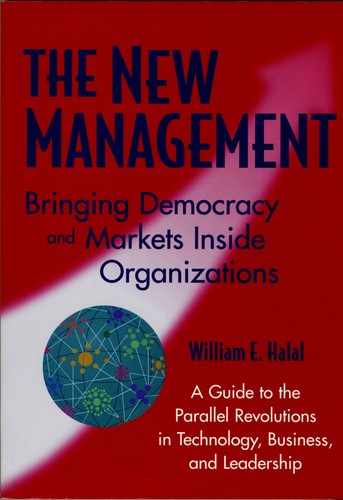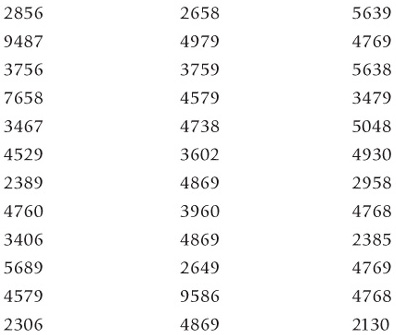Appendix A
The Organization Exercise
This exercise is designed to allow participants to experience the effects of different tasks on organization structure.
METHOD
The instructor should assign participants to groups of 3 to 7 people and have each group select a leader. The leaders are then asked to have their groups perform two different tasks, and the results are posted on a chalk-board or flipchart.
The first task is to add up a page full of random numbers and produce a total. (See Exhibit 1. The correct answer is 161,280.) The instructor should make it clear that group leaders are free to go about this assignment any way they choose and that they are competing against the other groups to obtain a reasonably close answer in the shortest time possible. After starting, the instructor notes the elapsed time as each group produces a good answer, and posts the time. Groups are then asked to describe how they organized themselves on a scale of 0 (mechanistic) to 10 (organic). These results are posted under the heading “Organization Structure.”
Groups are then instructed to complete the second task, which involves a more complex assignment of assembling a puzzle, such as the cutout shown in Exhibit 2. The instructor again notes completion times and obtains descriptions of group organization ranging from 0 to 10, and posts these results, as before.
RESULTS
With these data posted, the instructor then moves to the analysis phase of the exercise.
The data for “organization structure” are averaged for each task, and groups are asked to describe how they experienced the two tasks, focusing on the type of organization structures they created. Based on the assumption that the two tasks present challenges of differing complexity, these data usually show that the more complex task (the puzzle) encourages more organic structures.
The instructor can also demonstrate more sophisticated results by plotting “organization structure” versus “performance time” and other relationships. Many different and instructive scatterplots of this type can be used, especially if additional data are obtained from groups, such as “satisfaction” measures. It is also useful to encourage groups to discuss and compare their experiences.
CONCLUSION
This exercise tends to consistently demonstrate a few central conclusions. First, more complex tasks tend to require more organic structures. Second, people tend to prefer working in organic structures. Finally, organic structures, such as networking and internal markets, should be more effective for organizations generally because of the complexity of most task environments and because of personal preferences of most workers.
Appendix B
The Stakeholder Meeting
A Role-Play Simulation of the Organization
as a Socioeconomic System
This exercise is designed to simulate a stakeholder meeting that approximates the reality of organizational life as an extended socioeconomic system consisting of various “subsystems,” “constituencies,” or “stakeholders,” as described below. The managers of this organization should open the meeting, define the agenda, conduct the proceedings, and close the meeting. Although managers should behave as they see fit, the simulation is most valuable if they allow each group to be heard, address the issues raised, and generally encourage a lot of interaction. Total time for the exercise should be limited to about thirty minutes.
The objective is to engage in a fresh learning experience that simply allows us to explore how such a system would work, its strengths and weaknesses, points of conflict and agreement, and how the system could be managed more effectively. Simply do what seems reasonable from the perspective of the role you are playing.
SOME ISSUES TO CONSIDER
Management
This would be the CEO, president, or general manager of a corporation; the secretary or director of a public agency, and so forth. Managers have the central role in a stakeholder meeting because they serve as the hub of this extended system, so ideally, their job is to reconcile all stakeholder interests and draw these groups into a unified, productive coalition. To do this, it is useful if they can present a coherent, stimulating vision of the organization that will inspire people to work together, and then to help iron out differences: the need for capital from investors, productivity and service of employees, needs of clients, assistance from associated organizations, regulatory relief and support from government, and so on.
Officers from a financial institution may represent stockholders of a corporation; congressional representatives would stand up for taxpayers in the case of a government agency. Investors typically think they “own” the organization, so they tend to impose their concerns about poor performance, focusing on profit in the case of business and taxes in the case of government. Management’s challenge is to help investors to acknowledge that other groups have equally legitimate claims on the organization’s performance and that these interests do not necessarily conflict with making money.
Employees
Employees are usually represented by labor leaders and/or ordinary workers in stakeholder meetings. This group typically feels abused by management’s authority and concerned about low wages, dull jobs, layoffs, and lack of dignity, so they usually make unreasonable demands and oppose management proposals. Their main issue is to find a way to be involved as constructive partners in raising productivity, quality, and the like, in return for higher pay and other benefits.
Clients
This group might be represented by average clients or possibly a consumer advocate. Clients are usually critical and hard to please, often threatening to take their business elsewhere if they can. Yet they can be a source of creative ideas since they usually know their needs best, even if they have difficulty articulating them, and their faithful patronage is essential, obviously.
Associated Organizations
In business, associated organizations are suppliers, distributors, partners, and the like, while in government they are private contractors and other agencies. These groups tend to feel defensive because they are dependent upon the larger host organization for their survival, whereas the reverse is also true.
The Public
Politicians usually represent the public at local, state, and federal governments. They provide the infrastructure but also control organizations through regulations and taxes, so a constructive relationship is needed that enhances the benefits for the various levels of government and the organization.
SOME QUESTIONS TO CONSIDER FOLLOWING THE EXERCISE
Was this simulation realistic?
What is common to all these relationships?
Is the investor’s relationship unique?
To what extent are all these interests compatible?
How could their interests be better served?
What should be the goal of the organization?
What information, type of governance, etc., is needed to manage this system better?
How do you personally feel about this system?
What do you think will happen over the long term?
What are the implications of this type of organizational governance for national economies? Would it still be capitalism? Free enterprise? Socialism? A worker’s democracy? A consumer cooperative? Are other terms more meaningful?
Appendix C
Corporations in Transition Study
The questionnaire in this appendix was used to survey 426 managers from the United States, Europe, and Japan. Results are referred to throughout this book.
The questionnaire is reproduced here to allow you to see how the study was conducted and to invite you to extend the study to your organization. So please feel free to copy the next few pages in order to have the questionnaire completed by you and your colleagues. You can then compare your results with those of the entire sample in this book, use the data to analyze your management approach and that of your organization, and consider what changes you would like to make. I would be extremely pleased if you could send me copies of your responses to add to my growing data base, along with any suggestions, criticism, new questions, or any other feedback you care to offer. A larger, more up-to-date collection of data would greatly help in understanding how the New Management is evolving. I can be reached at the following address:
Professor William E. Halal
Department of Management Science, Monroe Hall
George Washington University
Washington, D.C. 20052
PHONE: 202-994-5975
FAX: 202-994-4930
E-MAIL: [email protected]
CORPORATIONS IN TRANSITION STUDY
This survey is intended to assess the transition from the “Old Management” to the “New Management.” The Old Management is defined as the hierarchical, authoritarian form of business that worked well in the Industrial Age, while the New Management is defined as the entrepreneurial, collaborative form of business now emerging for an Information Age. The results are to be used for university research, which may then be published in business journals. Naturally, your responses will be treated with strict confidence and only aggregated data will be used.
Instructions: Each question below describes a “New Management practice” as clearly as possible and asks you to indicate how your company is now managed. Circle one number along the scale for 0 to 10 that best describes the extent to which this type of management is “Not Practiced at All” versus “Practiced Completely.” Please try your best to make an accurate estimate, but leave the question blank if you really do not know or if this does not apply to your company for some reason. We would also appreciate any comments you can offer to explain your answer, to describe a new management practice that does not fit our categories, offer suggestions for improving the study, or anything else. If you need more space, use the back of this form.
My graduate students and I thank you sincerely for your help. In return, we will be happy to share the results with you.
PROFESSOR WILLIAM HALAL
Background Data
Name of your organization:
Number of employees:
Annual revenue:
Type of industry:
Your position:
Country in which the operations you are describing are located:
ORGANIZATIONAL STRUCTURE
1. Operating units are treated as semiautonomous enterprises that have control of their own operations and keep most of their revenue.
NOT PRACTICED AT ALL 0 1 2 3 4 5 6 7 8 9 10 PRACTICED COMPLETELY
COMMENTS:
2. Staff and support units (HRD, Legal, IS, etc.) are treated as profit centers that obtain revenue by selling their services to other units.
NOT PRACTICED AT ALL 0 1 2 3 4 5 6 7 8 9 10 PRACTICED COMPLETELY
COMMENTS:
3. Operating units are generally allowed to buy products and services from any organization, inside or outside of the company.
NOT PRACTICED AT ALL 0 1 2 3 4 5 6 7 8 9 10 PRACTICED COMPLETELY
COMMENTS:
4. Staff and support units are generally allowed to sell their services to any organization, inside or outside of the company.
NOT PRACTICED AT ALL 0 1 2 3 4 5 6 7 8 9 10 PRACTICED COMPLETELY
COMMENTS:
5. Apart from proprietary secrets, employees have access to central information systems that contain all available company information.
NOT PRACTICED AT ALL 0 1 2 3 4 5 6 7 8 9 10 PRACTICED COMPLETELY
COMMENTS:
GOALS AND GOVERNANCE
1. The company strives to maintain cooperative working relationships with important stakeholders. (For instance, investors, employees, customers, suppliers, distributors, the local community, and possibly other groups.)
NOT PRACTICED AT ALL 0 1 2 3 4 5 6 7 8 9 10 PRACTICED COMPLETELY
COMMENTS:
2. The company’s primary goal is to serve the interests of important stakeholders, including making money for investors.
NOT PRACTICED AT ALL 0 1 2 3 4 5 6 7 8 9 10 PRACTICED COMPLETELY
COMMENTS:
3. In addition to profitability, corporate performance is evaluated by a formal system that assesses how well important stakeholders are served.
NOT PRACTICED AT ALL 0 1 2 3 4 5 6 7 8 9 10 PRACTICED COMPLETELY
COMMENTS:
4. The board of directors includes employees and other important stakeholders.
NOT PRACTICED AT ALL 0 1 2 3 4 5 6 7 8 9 10 PRACTICED COMPLETELY
COMMENTS:
5. Apart from proprietary secrets, employees have access to central information systems that contain all available company information.
NOT PRACTICED AT ALL 0 1 2 3 4 5 6 7 8 9 10 PRACTICED COMPLETELY
COMMENTS:
MARKETING AND SALES
1. In addition to sales levels, customer satisfaction is evaluated by customer surveys and interviews, monitoring complaints, and other formal systems.
NOT PRACTICED AT ALL 0 1 2 3 4 5 6 7 8 9 10 PRACTICED COMPLETELY
COMMENTS:
2. The views of customers are solicited by product designers, managers, or other personnel when making decisions about products and services.
NOT PRACTICED AT ALL 0 1 2 3 4 5 6 7 8 9 10 PRACTICED COMPLETELY
COMMENTS:
3. Customers can use a toll-free line for information and to have problems corrected.
NOT PRACTICED AT ALL 0 1 2 3 4 5 6 7 8 9 10 PRACTICED COMPLETELY
COMMENTS:
4. Advertising is designed to provide useful information rather than inflated claims.
NOT PRACTICED AT ALL 0 1 2 3 4 5 6 7 8 9 10 PRACTICED COMPLETELY
COMMENTS:
5. A significant portion of operating managers’ pay is based on customer satisfaction.
NOT PRACTICED AT ALL 0 1 2 3 4 5 6 7 8 9 10 PRACTICED COMPLETELY
COMMENTS:
EMPLOYEE RELATIONS
1. A significant portion of employee pay is based on performance incentive systems.
NOT PRACTICED AT ALL 0 1 2 3 4 5 6 7 8 9 10 PRACTICED COMPLETELY
COMMENTS:
2. Employee attitude surveys are conducted periodically.
NOT PRACTICED AT ALL 0 1 2 3 4 5 6 7 8 9 10 PRACTICED COMPLETELY
COMMENTS:
3. Employees are encouraged to develop their creative ideas into new ventures.
NOT PRACTICED AT ALL 0 1 2 3 4 5 6 7 8 9 10 PRACTICED COMPLETELY
COMMENTS:
4. Employees are organized into self-managed teams that choose their leaders, work methods, equipment, hours, co-workers, and most other aspects of their work.
NOT PRACTICED AT ALL 0 1 2 3 4 5 6 7 8 9 10 PRACTICED COMPLETELY
COMMENTS:
5. Employees can use information systems to “telework” from home, in the field, and other locations.
NOT PRACTICED AT ALL 0 1 2 3 4 5 6 7 8 9 10 PRACTICED COMPLETELY
COMMENTS:
ENVIRONMENTAL MANAGEMENT
1. Environmental impacts are studied as they affect product design, manufacturing processes, packaging, waste treatment, recycling, and other aspects of operations.
NOT PRACTICED AT ALL 0 1 2 3 4 5 6 7 8 9 10 PRACTICED COMPLETELY
COMMENTS:
2. Environmental costs and benefits are incorporated in management decisions.
NOT PRACTICED AT ALL 0 1 2 3 4 5 6 7 8 9 10 PRACTICED COMPLETELY
COMMENTS:
3. The company solicits advice from an environmental advisory committee and/or various environmental groups.
NOT PRACTICED AT ALL 0 1 2 3 4 5 6 7 8 9 10 PRACTICED COMPLETELY
COMMENTS:
STRATEGIC CHANGE
1. A formal strategic planning process is conducted periodically to determine how corporate strategy should respond to technological advances, economic conditions, social attitudes, and other critical issues.
NOT PRACTICED AT ALL 0 1 2 3 4 5 6 7 8 9 10 PRACTICED COMPLETELY
COMMENTS:
2. Unit managers are free to pursue their own strategies for their units.
NOT PRACTICED AT ALL 0 1 2 3 4 5 6 7 8 9 10 PRACTICED COMPLETELY
COMMENTS:
3. Top management encourages major structural changes when they are needed.
NOT PRACTICED AT ALL 0 1 2 3 4 5 6 7 8 9 10 PRACTICED COMPLETELY
COMMENTS:
LEADERSHIP
1. The leadership style of management is participative in most respects.
NOT PRACTICED AT ALL 0 1 2 3 4 5 6 7 8 9 10 PRACTICED COMPLETELY
COMMENTS:
2. The corporate mission is well defined and generally accepted.
NOT PRACTICED AT ALL 0 1 2 3 4 5 6 7 8 9 10 PRACTICED COMPLETELY
COMMENTS:
3. Major decisions and disagreements are discussed openly to reach consensus among those concerned.
NOT PRACTICED AT ALL 0 1 2 3 4 5 6 7 8 9 10 PRACTICED COMPLETELY
COMMENTS:
GENERAL
1. Generally speaking, do you think these practices making up The New Management (TNM) are needed?
NO YES UNSURE
COMMENTS:
2. Why are some companies not using TNM?
RESISTANCE TO CHANGE SHORT-TERM FOCUS IDEAS ARE UNACCEPTABLE UNSURE
COMMENTS:
3. What will happen to firms that do not adopt TNM?
THEY WILL SURVIVE MARGINAL EXISTENCE LIKELY TO FAIL UNSURE
COMMENTS:
4. When is TNM likely to enter the mainstream of business?
1996 2000 2005 LATER UNSURE
COMMENTS:
Thanks very much for your time and thoughtful responses.


